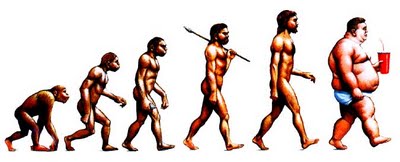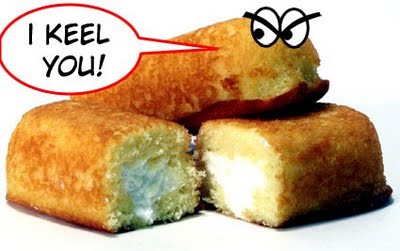Junk In More Than Just The Trunk (Or I Can't Believe Our Cows Eat Twinkies - Part Moo)
Okay, I promise... This is it for awhile on my bitching about the American food supply. Friday, we had "I Can't Believe Our Cows Eat Twinkies... (Part Uno).
And without further adieu, here is the last bish session on food for yieu and yieu and yieu. (At least until next time. And come on, I seldom cover such dark material without a little bit of fun, right? RIGHT?? OUI OR NON?? Oui... I hope.)
Growing fast food: Cattle fed on corn eventually become sick and die. Via a transcript from Fresh Air on NPR with Terry Gross
GROSS: "Let’s get back to the cow’s stomach."
Mr. POLLAN: "Yeah."
GROSS: "So the cow now is eating corn instead of eating grass. Its stomach is made for digesting grass and turning it into protein. How does the cow’s digestive system handle corn?"
Mr. POLLAN: "Well, very poorly. It’ll go kablooey if it’s not done very gradually. And I talked to people who said that most cows, most beef cattle getting a heavy diet of corn–and again, they can tolerate some of it, but when you crank it up to 70, 80, 90 percent grain, their stomachs go haywire. They suffer from a range of different phenomenon, one of which is bloat.
"You know, the rumen, this organ, is always producing copious amounts of gas, and these are expelled during rumination, you know, when the animal kind of chews its cud. It regurgitates this bolus of grass and in the process releases all this greenhouse gas, essentially methane and things because when you’re digesting grass much gas is produced. But when they’re eating corn, this layer of slime forms over the mass in the rumen, and it doesn’t allow the gas to escape. So what happens is the rumen begins to expand like a balloon until it’s pressing up against the lungs of the animal. And if nothing is done to release the pressure of that gas, the animal suffocates. It can’t breathe anymore. So what do they do? Well, if it gets to that point, they force a hose down the esophagus of the animal, and that releases the gas, and they very quickly put them back on hay for a little while.
"So that’s one of the things that can go wrong. Well, perhaps the most dramatic. But a whole other range of problems are created because the corn acidifies the rumen. The rumen has basically a neutral pH when it’s healthy and getting grass, and that’s very significant for a lot of reasons. But you feed it corn and it gets a lot more acidic. And the rumen can’t deal with acids, and what happens is the acids gradually eat away at the wall of the rumen, creating little lesions or ulcers through which bacteria can pass. And the bacteria get into the bloodstream and travel down to the liver, which collects all such impurities, and infects the liver. And that is why more than 13 percent of the animals slaughtered in this country are found to have abscessed livers that have to be thrown away and is a sign of disease.
"But this low-level sickness, acidosis or even subacute acidosis, as they call it, afflicts many, many–probably the majority–of feedlot calves, and it leaves them vulnerable to all sorts of other diseases. Their immune systems are compromised. So they get this, you know, horrifying list of feedlot diseases. You know, we have these diseases of civilization, you know, heart disease and such things. Well, they have their own diseases of civilization: feedlot polio, abscessed livers, rumenitis, all these kinds of things that cows in nature simply don’t get."
GROSS: "Is this where the antibiotics come in?"
Mr. POLLAN: "Yeah. The only way you can keep a cow alive getting this much corn would be with antibiotics. And they get large quantities of antibiotics with their feed every day. They get rumensin, which is technically an ionophore. It’s a kind of antibiotic that helps with the bloat and the acidosis. And then they get tylosin, which is in the erythromycin family. And that antibiotic cuts down on the incidence of liver disease, and without that, they would all have liver disease probably.
"So, you know, when people debate antibiotics in livestock, which is a very, you know, important issue, and it’s before the Congress right now, they make this easy distinction between feeding animals antibiotics to promote growth, which is done in the chicken industry and the pig industry, and then feeding them when they’re sick, which even the public health advocates against using antibiotics in livestock say, ‘Of course it’s fine. You must treat sick animals.’ But where do you put the beef calf who is clearly getting these antibiotics to cure him? On the other hand, he wouldn’t be sick if we weren’t feeding him what we feed him? So it kind of confounds the usual distinction. If you took away these antibiotics, everything would have to change."
GROSS: "Michael Pollan’s article on the beef industry was published in Sunday’s New York Times Magazine. His book, “The Botany of Desire,” will be published in paperback next month. We’ll talk more about the beef industry in the second half of the show. I’m Terry Gross, and this is FRESH AIR."
(Announcements)
GROSS: "Coming up, the consequences of feeding cattle antibiotics and hormones. We continue our conversation with Michael Pollan about the modern industrial steak."
(Soundbite of music)
GROSS: "This is FRESH AIR. I’m Terry Gross, back with Michael Pollan. We’re talking about how cattle are raised and fed in today’s industrialized beef industry. Michael Pollan’s article, This Steer’s Life, was the cover story of last Sunday’s New York Times Magazine. He usually writes about gardening and organic food. His book “The Botany of Desire: A Plants-Eye View of the World” will be published in paperback next month. When we left off, we were talking about why cattle are fed antibiotics along with their corn feed. Well, the corn wreaks havoc on the cow’s digestive system. The digestive problems are addressed with antibiotics.
"Now what about the effects of the antibiotics on we humans that eat the cow meat? Is there still antibiotic residue in the meat?"
Mr. POLLAN: "Yes, they have found recently that there are antibiotic residues. But the larger problem–and this is one of the key connections between their health and our health, which I believe you simply can’t separate–is that simply by putting this huge quantity of these antibiotic chemicals into the environment–you know, more than half of the antibiotics made in this country go to feed livestock–you are creating resistant bugs, resistant bacteria. This is how evolution works. If you put a poison in the environment, to a population, it will evolve to withstand that poison. And that is happening. And that can be proven. It happens downstream of feedlots in the water that’s getting away. It happens in the manure of the animals.
"In their digestive tract, right now, they are selecting for strains of bacteria that can withstand erythromycin, that can withstand penicillin, and those bacteria, having been created through this process, are now everywhere. And there is a connection between the antibiotics that steer number 534 is getting, and all his pen mates, and the fact that when my son has an ear infection, I have a hell of time finding an antibiotic now that will work. The reason that our antibiotics are failing is in part because we are squandering them on all these animals."
(Source)
So, there's a reason why this is timeless,
And this,
And this,

REALLY not so much. (BBBRRRRTTTTTTTT... There goes the waitress... WOULD SOMEBODY HELP HER PLEASE?? Thanks.)
And this,

REALLY NOT SO MUCH EITHER, DAMN IT. (I'm pretty sure he exploded two minutes after this pic was taken.)
In a time gone by, many ordered what seemed to be more civilized dishes, such as "Pheasant Under Glass", which origins are quite shaky. One report says, "Breast of pheasant is served under glass to hold in the cognac flavor that makes this dish so distinctive." While another says that it refers to not really "glass", but rather a glaze... Or rather a "glace", that is was pheasant en gelée, or covered with a savory gelatin... Who knows?
But now, I see something different in our midst,
Where, we're actually


the guinea pigs... And I'm not sure the pizza's even really pizza.
With our livestock eating all this crap, I wouldn't be surprised if our chickens,
were tweaking, dudes.
I know I am.
*** Eating organically (and responsibly) on a food-stamp budget.
***********************************





